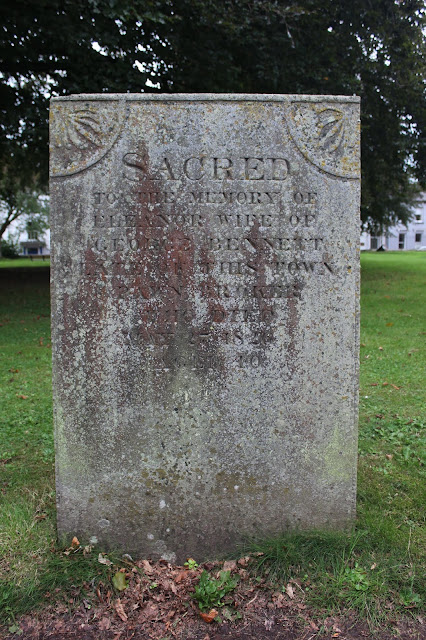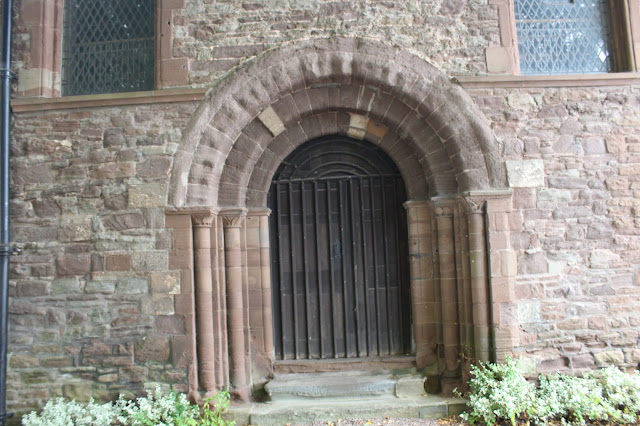Chester, Cheshire - St John the Baptist
 |
These two stones, laid as paving outside the church, are in memory of an Iron Master, and an Ostrich Feather Manufacturer - most unusual! |
 |
This monument shows a skeleton holding up a sheet inscribed with details of Diana Warburton, Wife and Relict of S. George Warburton. There are more skulls at the base of the monument. |
 |
This elaborate wall memorial bears an image of the deceased, a member of the Warburton family, who died in 1728 aged 63, and a lengthy inscription in Latin. |
 |
John Powell was sexton of this parish for 37 years, and died in August 1881. His son Frank Powell was sexton and verger of this church for 47 years and died in August 1931. |
 |
A wonderfully elaborate memorial to Mathew Anderton, who died in November, 1693. |
St Maughans, Monmouthshire - St Maughan
 |
John Axten was "a staunch servant of the Bank of England". He and his wife were both churchwardens of this church. She outlived him by about 37 years, and lived to be over 100 years old. |
 |
This memorial plaque inside the church must have been very colourful when it was installed after the death of John Lewis in 1740. |
Monmouth, Monmouthshire - St Thomas the Martyr
 |
The fine Norman style doorways are well worth admiring. |
 |
Close to the church, the gate tower on the Monnow Bridge is a unique example on a medieval bridge. |
Monmouth, Monmouthshire - St Mary Priory Church
 |
This most unusual gravestone has a "wordsearch" type inscription which reads "Here lies John Renie" in every direction. Start at the large central "H". |
 |
W. Howse was a saddler in Monmouth. |
 |
Eleanor was the wife of George Bennett, a pawnbroker, who died in 1826. |
 |
Elizabeth Powles was "for Several Years Principal Treble in the Choir of St Mary's Church". |
 |
"Reader only stand and think That I am in Eternity And thou art on the brink." |
 |
A careful look at this memorial tablet to the Phillpott family reveals that the inscription appears to have been made on top of an earlier inscription. |
 |
Robert Bevan was a Physician for more than thirty years to both the poor and the rich. |
Skenfrith, Monmouthshire - St Bridget
 |
Captain Thomas died of burns received in a flying accident in 1918, and this plaque was erected by one of his comrades of the battle of the Somme of 1916. |
 |
Aged 100 years. |
 |
This tomb is described in the notice shown below. |
 |
Vernon Handley, known as "Tod", a conductor, was particularly known for his support of British composers. He conducted many well known orchestras both in Europe and in the UK. |
 |
Unusually, this wall memorial inside the church is made entirely of wood. It remembers William Bovan who died in 1760, aged 66 years, and Rebecca his wife who died in 1762 aged 67 years. |
 |
This young man is remembered with a verse by C. Day Lewis. |
Grosmont, Monmouthshire - St Nicholas.
We have seen many slightly different versions of this "Physicians were in Vain" verse. |
"Missed by Skip". |
 |
The sombre verse reminds us of what may befall us all. |
 |
A rectangular tomb slab with marginal inscription and effigies of Charles William of Goytre (Mayor of Grosmont and Deputy Steward of Duchy of Lancaster) and his wife Joan Baker, dated 1636. |
Monmouth Cemetery, Monmouthshire
 |
 |
The cemetery was quite extensive, on quite hilly ground, neatly mown, and still in use for new burials. |
 |
These gravestones are in memory of men of the Royal Monmouthshire Royal Engineers who died in the early 20th century. |
 |
Joseph Dance was a Malster in Monmouth. |
 |
There is no obvious maritime connection for the inclusion of the lovely anchor and rope on this memorial. |
 |
The memorial to John Vaughan was erected by his comrades in No. 1 Company, R.M.R.E.(M) |
 |
Sgt. Charlesworth, Permanent Staff, R.M.R.E. |
 |
Died from injuries received at Bridgewater Station on May 3rd, 1892, aged 38 years. |
 |
Two sons, William and Sidney were killed in action in WWI, Bertie drowned at Symonds Yat aged 9 years, and three sons and a daughter died as babies and toddlers. |
 |
Aged 108 years. |
 |
A missionary in Bolivia for 29 years. |
 |
The signature of F.J. Hayes has been used on the gravestone. |
 |
John Gordon was born in the U.S.A. and was attendant of this cemetery for 25 years. |
Subscribe to:
Comments (Atom)























